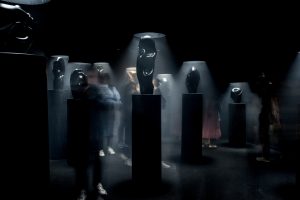Monologues. Indrė Stulgaitė-Kriukienė and Remigijus Kriukas' Art Glass Exhibition
13 September–13 November 2017. On 11–12th of November the exhibition is free of charge.

On 11–12th of November the exhibition is free of charge.
Glass art is a highly specific field having many unique technological characteristics, not to mention the fact that glass is a particularly temperamental material. One of the most favoured techniques of artists Indrė Stulgaitė-Kriukienė and Remigijus Kriukas is the hot-sculpting technique (blowing, casting and free-form), known for being especially difficult to handle. Just as important is cold-work glass production, especially when we are talking about optical, or very transparent, glass. It is a material of various meanings, various forms, concealing a mysterious added dimension; spell-binding, engrossing, expressing more than can be said with words alone. Glass! A material that introduced and united two creators, each one different, having their own unique touch, style and different creative experience, yet also alike – after all, they’re crazy about glass!
The artists organise original exhibitions, while also participating in joint glass art shows, projects and glass art symposiums. Realising their creative ideas, the creators constantly experiment, deepening their knowledge of various technological characteristics and try to make optimal use of the potential this exclusive material offers – transparency, clarity and illusion – combining clear and coarse surfaces.
Remigijus Kriukas has been working with glass for over three decades, while Indrė Stulgaitė-Kriukienė has been doing so for a little over a decade. “You really need to love glass to be able to control it. Spend great amounts of time with it, until you start to understand it better and better. And then one day, you feel that you know how to communicate with it. Glass sounds like warm jazz. Improvising with glass you can achieve the most surprising forms. This material is intangible, and at the same time it is very fragile. Large, bulky works do not appear heavy. A sense of fragility is revealed, because you can see the inside of the glass”, says Kriukas.
Remigijus is more inclined to producing larger pieces, using characteristic techniques he has made his own, combining details created using a particular casting method with clear chunks of optical glass thereby creating a rather original and interesting style of glass; he combines optical glass with cast, cut, sandblasted and polished glass. Some of his other favourite techniques are moulded glass, hot-sculpting, blown glass, and combinations with stone and metal.
Indrė produces smaller works. She not only devotes attention to the aesthetic aspect, but also to the existential ideas that linger in many of her pieces. The emotional expression of her works is important. Her favourite technique is hot-sculpting, as well as cut and polished glass, including combinations with other materials – wood and stone. Over the last several years, the author has been searching for new forms of expression of glass art, involving image and sound installations: “I am a doctoral student at the Vilnius Academy of Arts and my topic of research is specifically about how glass is transformed from something that is functional, into a modern, post modern and even conceptual work of art. I can say without any hesitation that the applied art label should finally be removed from glass art. It is very symbolic that this exhibition of ours is kind of like a provocation, as it is being held at the Museum of Applied Art and Design. Let’s leave it to the viewer to decide…”
The glass art exhibition “Monologues” unites two creators which speak different art languages. Sometimes their monologues come together, start to liken a dialogue or pass by each other, sometimes they do not approach one another at all. The artists’ “conversations” feature various topics, emotions and experiences.
In this exposition, which has especially been divided into two separate spaces, their works are displayed from the last several years. All the spaces are united under one common factor – glass. We see very different art works, both in a stylistic and a visual expression sense: sculptures, installations and image recordings. Visitors to the exhibition might have already seen some in other spaces, while other works were born just before the show. The exhibition also features the installation “4 Days on Mars” shown at this year’s international art fair ArtVilnius’17, where audiences voted it the best at the event,
and the artist duo became the unquestionable “Public’s Best Artists”.
3A Arsenalo st, Vilnius, Lithuania
+370 5 212 1813;
+370 5 261 25 48; +370 5 262 80 80.
tddm@lndm.lt














